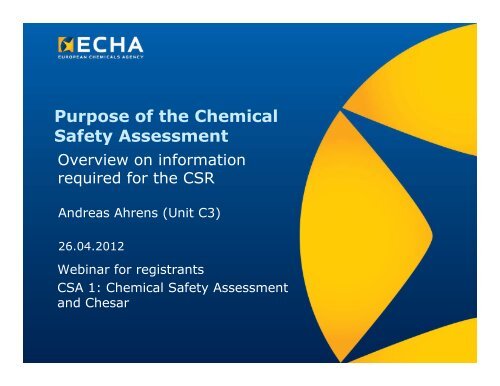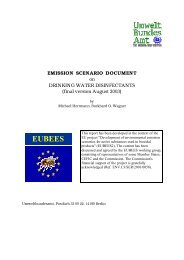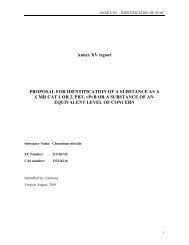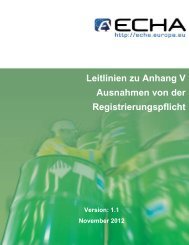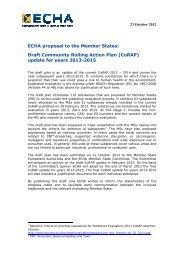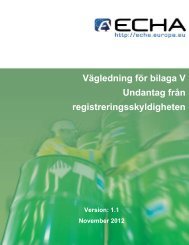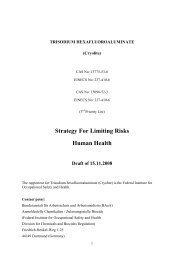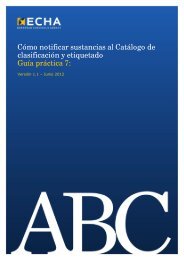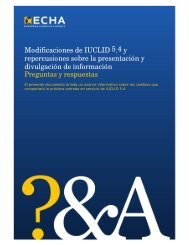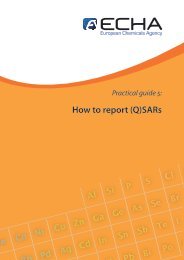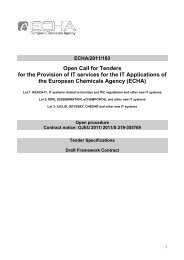Purpose of the Chemical Safety Assessment - ECHA - Europa
Purpose of the Chemical Safety Assessment - ECHA - Europa
Purpose of the Chemical Safety Assessment - ECHA - Europa
You also want an ePaper? Increase the reach of your titles
YUMPU automatically turns print PDFs into web optimized ePapers that Google loves.
<strong>Purpose</strong> <strong>of</strong> <strong>the</strong> <strong>Chemical</strong><br />
<strong>Safety</strong> <strong>Assessment</strong><br />
Overview on information<br />
required for <strong>the</strong> CSR<br />
Andreas Ahrens (Unit C3)<br />
26.04.2012<br />
Webinar for registrants<br />
CSA 1: <strong>Chemical</strong> <strong>Safety</strong> <strong>Assessment</strong><br />
and Chesar
Overview<br />
• <strong>Purpose</strong> <strong>of</strong> <strong>Chemical</strong> <strong>Safety</strong> <strong>Assessment</strong><br />
• <strong>Assessment</strong> workflow<br />
• From study records to hazard assessment conclusions<br />
• Conditions <strong>of</strong> use<br />
• Exposure estimates<br />
• Some challenges<br />
2
<strong>Purpose</strong> <strong>of</strong> CSA<br />
3
CSA in a nutshell<br />
• Determine <strong>the</strong> hazards based on <strong>the</strong> information required<br />
for registration <strong>of</strong> <strong>the</strong> substance<br />
• Describe <strong>the</strong> conditions <strong>of</strong> safe use (operational conditions<br />
and risk management)<br />
• => set <strong>of</strong> exposure scenarios addressing all identified<br />
uses<br />
• Estimate <strong>the</strong> expected exposure under <strong>the</strong>se conditions<br />
• Compare <strong>the</strong> expected exposure with <strong>the</strong> hazards<br />
• Conclude whe<strong>the</strong>r control <strong>of</strong> risk is demonstrated; refine <strong>the</strong><br />
assessment, if needed;<br />
• Annex I <strong>of</strong> REACH sets out <strong>the</strong> general provisions for <strong>the</strong><br />
assessment<br />
4
Registration under REACH<br />
Technical Dossier including information as<br />
required according to Annexes VI-XI <strong>of</strong> REACH<br />
(may include also exposure information)<br />
<strong>Chemical</strong> <strong>Safety</strong> <strong>Assessment</strong><br />
Hazard <strong>Assessment</strong><br />
Exposure <strong>Assessment</strong><br />
Risk Characterisation<br />
<strong>Chemical</strong> <strong>Safety</strong> Report<br />
5
When is a CSA required?<br />
• Required if <strong>the</strong> substance is manufactured or imported at 10<br />
tonnes or more per year<br />
• The CSA includes exposure assessment and risk<br />
characterisation for all <strong>the</strong> identified hazards<br />
• if one <strong>of</strong> <strong>the</strong> criteria is met to classify <strong>the</strong> substance as<br />
hazardous, or<br />
• if <strong>the</strong> substance is to be treated as PBT/vPvB, or<br />
• if information requirements are adapted based on exposure<br />
considerations according to Annex XI (3)<br />
• Identified hazards = adverse effects observed based on<br />
guideline studies (or o<strong>the</strong>r adequate information)<br />
6
<strong>Purpose</strong> <strong>of</strong> <strong>the</strong> CSA process (1)<br />
• Describe <strong>the</strong> conditions ensuring control <strong>of</strong> risks<br />
arising from <strong>the</strong> manufacture and use(s) <strong>of</strong> a<br />
substance<br />
• Identify where fur<strong>the</strong>r information is needed<br />
(exposure data or testing <strong>the</strong> substance).<br />
• Inform users <strong>of</strong> <strong>the</strong> substance on <strong>the</strong> conditions <strong>of</strong><br />
safe use (via exposure scenario attached to <strong>the</strong> SDS)<br />
• Document <strong>the</strong> assessment in a CSR for <strong>the</strong><br />
companies’ own documentation.<br />
7
<strong>Purpose</strong> <strong>of</strong> <strong>the</strong> CSA process (2)<br />
• Submit CSR to <strong>the</strong> authorities (<strong>ECHA</strong> and MS)<br />
• to justify i) additional testing <strong>of</strong> vertebrates or ii) <strong>the</strong><br />
omission <strong>of</strong> information requirements<br />
• as <strong>the</strong> source <strong>of</strong> information for regulatory processes, e.g.<br />
selecting substances for substance evaluation or for<br />
candidate list authorisation<br />
• to enable spot checks on dossier compliance<br />
8
<strong>Assessment</strong><br />
work flow<br />
9
<strong>Assessment</strong> Workflow<br />
Fulfil information<br />
requirements for <strong>the</strong><br />
various endpoints<br />
Derive hazard assessment<br />
conclusions (DNELs,<br />
PNECs, classification);<br />
CSR to authorities<br />
Exposure scenario building,<br />
exposure estimation, risk<br />
characterisation<br />
Describe <strong>the</strong> uses <strong>of</strong> <strong>the</strong> substance;<br />
compile information on<br />
<strong>the</strong> existing conditions <strong>of</strong> use<br />
Communicate information on<br />
substance properties and<br />
conditions <strong>of</strong> safe use via<br />
extended SDS<br />
4/25/2012
Risk Characterisation (RC)<br />
Hazard<br />
information<br />
Quantitative:<br />
PNEC/DNEL<br />
Qualitative:<br />
Classification (type<br />
and level <strong>of</strong> hazard)<br />
Quantitative/Qualitative<br />
Risk Characterisation<br />
Use and<br />
exposure<br />
information<br />
Exposure<br />
Scenarios<br />
Exposure<br />
Estimates
<strong>Assessment</strong> types<br />
<strong>Assessment</strong><br />
Type<br />
Exposure Scenario<br />
(conditions <strong>of</strong> use)<br />
Exposure estimation Risk characterisation<br />
Quantitative yes yes RCR < 1<br />
Semiquantitative<br />
yes yes exposure < threshold +<br />
additional argument<br />
Qualitative yes may be required to<br />
demonstrate<br />
minimisation<br />
control strategy<br />
corresponds to hazard
Mandatory elements <strong>of</strong> <strong>the</strong> CSA/CSR (1)<br />
• <strong>Assessment</strong> <strong>of</strong> intrinsic properties/hazards<br />
• physicochemical properties, “environmental fate”<br />
properties<br />
• Human health hazard<br />
• Local effects (skin, eyes, or respiratory tract)<br />
• Systemic effects (intake via skin, inhalation or oral)<br />
• effects after single event exposure (short term) or<br />
after repeated/long-term exposure<br />
• effects due to flammability, explosivity, oxidising<br />
potential<br />
• Environmental hazards: Adverse effects on organisms in<br />
water, sediments, soil or waste water treatment plant;<br />
adverse effects on predators (aquatic and terrestrial)<br />
13
Mandatory elements <strong>of</strong> <strong>the</strong> CSA/CSR (2)<br />
• Use identification for <strong>the</strong> full life cycle<br />
• Exposure assessment<br />
• Conditions <strong>of</strong> use (operational condition and risk<br />
management)<br />
• Corresponding release and exposure estimates<br />
• Risk characterisation<br />
• Quantitative: Compare estimated exposure with PNEC or<br />
DNEL. RCR < 1 indicates control <strong>of</strong> risk<br />
• Qualitative: Compare estimated exposure and/or foreseen<br />
risk management with type and level <strong>of</strong> hazard.<br />
14
From study records<br />
to hazard assessment<br />
conclusions<br />
- Examples -<br />
<strong>ECHA</strong>.EUROPA.EU<br />
15
Hazard assessment information in IUCLID<br />
INTERNAL<br />
16
Example (1): Overview on endpoint<br />
summaries in section 5.11 <strong>of</strong> <strong>the</strong> CSR<br />
Source: IUCLID 5.4, section 7<br />
Endpoint Route Dose descriptor or qualitative effect characterisation;<br />
test type;<br />
Acute toxicity<br />
Acute toxicity<br />
Acute toxicity<br />
Irritation / Corrosivity<br />
Irritation / Corrosivity<br />
Irritation / Corrosivity<br />
Sensitisation<br />
Repeated dose toxicity<br />
Repeated dose toxicity<br />
Repeated dose toxicity:<br />
Mutagenicity<br />
Reproductive toxicity: fertility<br />
impairment<br />
Oral No adverse effect observed<br />
Dermal No adverse effect observed<br />
inhalation No adverse effect observed<br />
Skin irritating<br />
Eye irritating<br />
respiratory No study available<br />
Skin No adverse effect observed (not sensitising)<br />
Oral NOAEL: 700 mg/kg bw/day (subacute; rat)<br />
Dermal No study available<br />
inhalation No study available<br />
No adverse effect observed (negative)<br />
Oral No adverse effect observed
Example (2): Hazard conclusions in<br />
section 5.11 <strong>of</strong> <strong>the</strong> CSR<br />
Source: IUCLID 5.4, section 7 (overall toxicological summary)<br />
Route Type <strong>of</strong> effect Hazard conclusion Most sensitive endpoint<br />
(referring to original study)<br />
Inhalation<br />
Dermal<br />
Systemic effect - Long-term DNEL = 24.7 mg/m3 Repeated dose toxicity (oral)<br />
Systemic effects -Acute No hazard identified Acute toxicity (Inhalation)<br />
Local effects - Long-term Hazard unknown (no fur<strong>the</strong>r<br />
information necessary)<br />
Local effects - Acute Hazard unknown (no fur<strong>the</strong>r<br />
information necessary)<br />
Systemic effect - Long-term DNEL = 7 mg/kg bw /day Repeated dose toxicity (oral)<br />
Systemic effects -Acute No hazard identified Acute toxicity (dermal)<br />
Local effects - Long-term Low hazard Skin irritation/corrosion<br />
Local effects - Acute Low hazard Skin irritation/corrosion<br />
Eyes Local effects - Acute Low hazard Eye irritation<br />
Remark: Table expected for workers and for general population
Example (3): Scope <strong>of</strong> exposure assessment<br />
for human health in section 9.02<br />
Route Type <strong>of</strong> effect Type <strong>of</strong> risk<br />
characterisation<br />
Inhalation<br />
Dermal<br />
Hazard conclusion (see section<br />
5.11)<br />
Systemic effect - Long-term Quantitative DNEL = 24.7 mg/m3<br />
Systemic effects -Acute Not required No hazard identified<br />
Local effects - Long-term Qualitative Hazard unknown (no fur<strong>the</strong>r<br />
information required)<br />
Local effects - Acute Qualitative Hazard unknown (no fur<strong>the</strong>r<br />
information required))<br />
Systemic effect - Long-term Quantitative DNEL = 7 mg/kg bw /day<br />
Systemic effects -Acute - Not required No hazard identified<br />
Local effects - Long-term Qualitative Low hazard<br />
Local effects - Acute Qualitative Low hazard<br />
Eyes Local effects –Acute Qualitative Low hazard<br />
19
Example (4): Explanation <strong>of</strong> DNEL<br />
derivation in section 5.11 <strong>of</strong> <strong>the</strong> CSR<br />
Inhalation<br />
(Long-term -<br />
systemic effects)<br />
Dermal (Longterm<br />
- systemic<br />
effects)<br />
DNEL derivation method:<br />
<strong>ECHA</strong> REACh guidance<br />
Dose descriptor starting point<br />
NOAEC = 617 mg/m3<br />
DNEL derivation method:<br />
<strong>ECHA</strong> REACh guidance<br />
Dose descriptor starting point<br />
NOAEL = 700 mg/kg bw/day<br />
<strong>Assessment</strong> factors for DNEL derivation<br />
AF for difference in duration <strong>of</strong> exposure: 2 (DNEL is based on an<br />
oral 90 day study)<br />
AF for interspecie differences: 1 (AF not used for inhalation route)<br />
AF for o<strong>the</strong>r interspecie differences: 2.5<br />
AF for intra species differences:5 (workers)<br />
Overall <strong>Assessment</strong> Factor: 25<br />
AF for difference in duration <strong>of</strong> exposure: 2 (based on an oral 90 day<br />
study)<br />
AF for interspecie differences: 4 (experimental animal was rat)<br />
AF for o<strong>the</strong>r interspecie differences: 2.5<br />
AF for intra species differences:5 (this is for workers)<br />
AF for remaining uncertainties:<br />
Overall <strong>Assessment</strong> Factor: 100<br />
Explanation for route to route extrapolation: …….<br />
20
Conditions <strong>of</strong> use<br />
Examples
Conditions <strong>of</strong> use (worker)<br />
• frequency and duration <strong>of</strong> exposure<br />
• physical state <strong>of</strong> product, e.g. dustiness, viscosity<br />
• concentration <strong>of</strong> substance in a preparation<br />
• amount used at a workplace<br />
• type <strong>of</strong> process carried out with <strong>the</strong> substance<br />
• level <strong>of</strong> containment or local exhaust ventilation<br />
• general ventilation and room volume before inhalation<br />
• personal respiratory protection<br />
• skin contact area and personal skin protection<br />
22
Conditions <strong>of</strong> use (environment)<br />
• Daily and annual tonnage used at generic sites<br />
• Daily and annual tonnage in wide disperse use<br />
• Process conditions driving <strong>the</strong> initial release<br />
• Onsite risk management measures (with certain<br />
effectiveness)<br />
• Flow rate <strong>of</strong> local sewage treatment plant and river<br />
flow rate.<br />
23
Conditions <strong>of</strong> use (consumer)<br />
• Type <strong>of</strong> product<br />
• Concentration <strong>of</strong> substance in <strong>the</strong> product<br />
• Number <strong>of</strong> events (product uses) per day<br />
• Amount <strong>of</strong> product per event<br />
• Duration <strong>of</strong> exposure<br />
• Room size and ventilation conditions<br />
• Skin surface exposed<br />
• Relevance <strong>of</strong> oral contact<br />
Conditions are <strong>of</strong>ten<br />
inherently related to<br />
<strong>the</strong> product type;<br />
based on habits and<br />
practices (if analysed)<br />
for many product types<br />
defaults are available<br />
24
Exposure estimates<br />
25
Human exposure<br />
Exposure to be measured<br />
or modelled<br />
26
Environmental release and exposure<br />
Industrial soil<br />
(regional)<br />
Local releases from industrial settings<br />
air<br />
deposition<br />
grassland arable land<br />
sludge<br />
air groundwater<br />
WWTP/ STP<br />
sediment<br />
27
Exposure estimates can be derived from...<br />
• Tier 1 tools<br />
• Higher Tier tools<br />
• Measured data<br />
Challenges:<br />
• Carry out measurements representing relevant<br />
conditions <strong>of</strong> use<br />
• Express input parameters <strong>of</strong> existing Tier 1 tools as a<br />
condition <strong>of</strong> use that can be communicated as advice<br />
to downstream users<br />
• Identify conditions <strong>of</strong> use corresponding to available<br />
measured data sets
Initial Exposure Scenarios<br />
• Short title<br />
• Current operational conditions<br />
• Current risk management measures<br />
Final Exposure Scenarios<br />
• Short title<br />
• Operational conditions (OC)<br />
• Risk management measures (RMM)<br />
Output: Exposure Scenarios<br />
<strong>Assessment</strong><br />
If risk not demonstrated to<br />
be controlled<br />
Decisions by M/I<br />
• Refine hazard assessment<br />
• Refine exposure estimate<br />
• More stringent RMM or OC<br />
• Advise against use (if<br />
control <strong>of</strong> risk cant be<br />
demonstrated)<br />
29
Challenges
M/I sells substance<br />
in mixture<br />
end-use <strong>of</strong> mixture<br />
by consumer<br />
M/I <strong>of</strong> substance<br />
as such<br />
DU (1) produces<br />
a mixture<br />
DU (2) produces<br />
a mixture<br />
Substance in article<br />
service life<br />
Some Challenges Challenges<br />
end-use <strong>of</strong> mixture<br />
by DU (3)<br />
Cover whole life cycle!<br />
Organise communication!<br />
Provide useful advice!<br />
Ensure consistency between<br />
CSR and SDSs!<br />
31
Thank you.<br />
Andreas Ahrens<br />
Andreas.Ahrens@echa.europa.eu<br />
32


